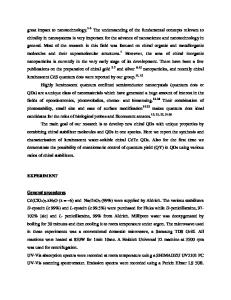Phonon Interaction in InGaAs/GaAs Quantum Dots
- PDF / 239,341 Bytes
- 5 Pages / 595 x 842 pts (A4) Page_size
- 14 Downloads / 358 Views
1053-EE03-03
Phonon Interaction in InGaAs/GaAs Quantum Dots Stefan Werner, Patrick Zimmer, André Strittmatter, and Axel Hoffmann Institut für Festkörperphysik, Technische Universität Berlin, Hardenbergstraße 36, Berlin, 10623, Germany ABSTRACT The carrier-phonon interaction in self-organized In(Ga)As/GaAs quantum dots is investigated under resonant excitation of the ground-state transition. Different phonon-coupled processes are observed. The distinction between Raman scattering and hot-luminescence process has been resolved by time-dependent photoluminescence measurements. The quantum dot LO (33.8 meV) as well as an interface (36.5 meV) phonon mode is observed by resonant Raman scattering. For the QD LO phonon mode, a very short radiative lifetime of 10 ps was found. INTRODUCTION In recent years, carrier-phonon interactions in self-organized semiconductor quantum dots (QDs) [1] have attracted considerable attention. They are important to understand the recombination and dephasing dynamics of confined excitons. Quantum dots may lead to different phonon modes because of interface boundaries or impurity atoms in the crystal. As a result of the local character of those phonon modes, the spatial overlap between electronic states and phonons is fairly large [2]. It has been shown experimentally and theoretically that single carriers [3, 4] and excitons [5-8] in QDs are strongly coupled to longitudinal optical (LO) phonons leading to the formation of QD excitonic polarons [7]. The observation of suppressed carrier relaxation has led to the prediction of a phonon bottleneck effect [2]. Additionally, exciton-phonon interactions have an influence on Raman scattering intensities and the intensities of the LO phonon sidebands of the QD ground state luminescence. Here, we present a combination of resonant Raman spectroscopy, and time-resolved as well as temperature-dependent photoluminescence measurements. Resonant Raman spectroscopy was performed in order to enhance the Raman cross-section. The resonant PL technique enables us to retrieve the energies of the localized phonon modes. However, PL measurements are often inappropriate to distinguish between different phonon-coupled processes like Raman scattering and hot-luminescence process. Raman scattering is expected to have a much shorter lifetime than any luminescence process. Therefore, time-resolved PL measurements were performed to enable us to differentiate between coherent and incoherent processes. EXPERIMENTAL DETAILS In order to investigate the influence of the QD phononic system on the electronic properties of the QD structures, resonant photoluminescence (PL) experiments were performed at low temperatures and at elevated temperatures up to room temperature. Resonant PL was excited by a continuously tunable Ti:Sa pumped optical parametric oscillator (OPO) and detected by an InGaAs photodetector. Time-resolved photoluminescence (TRPL) was carried out for the purpose of achieving lifetime constants of phonon-assisted processes. TRPL was detected by a multi-channel plat
Data Loading...








